
21 minute read
Company Profile
by IdeaSoil
The Architectural Team Reinvigorates Cities

Advertisement
Architecture and master-planning firm transforms neighborhoods and historical structures with a community-oriented mindset.
Design firms must evolve to endure. But what separates leading architects and planners from the rest is their commitment to founding principles. In the case of The
Above. Apartments at Boott Mills, one of The Architectural Team’s mill conversions, have reinvigorated the struggling gateway city of Lowell, MA, turning the textiles campus into a major mixedincome, mixed-use development. Photo: Bruce T. Martin
Architectural Team Inc., those core principles include safeguarding architectural legacies, revitalizing communities, and nurturing longstanding client relationships. A little loyalty to the firm’s hometown of Boston hasn’t hurt them either.
Originally founded in 1971 as Boston Architectural Team Inc.,
Right. The Architectural Team recently completed The Kensington, a LEED Gold market-rate luxury residential tower located at the confluence of Boston’s Chinatown, theater district, and financial district. Photo: Peter Vanderwarker
the firm then consisted of four founding partners, including managing principal Bob Verrier, FAIA. The nascent design firm made news the very next year, taking on the rehabilitation of 25 contiguous nineteenth-century bow-front buildings on the city’s South End. Just two years later, “the Team” completed the first of what would ultimately number more than 250 adaptive-reuse projects: Chauncy House, a downtown Boston high-rise that the firm repurposed as popular apartments.
The firm continued building a vaunted portfolio of market-rate and affordable housing, many as part of adaptive-reuse projects, as well as thousands of units of senior housing and assisted-living facilities. The firm became synonymous with the conversion of historical mills and lofts for this purpose, often restoring iconic structures that serve as touchstones for their neighborhood residents.
At the same time, the firm expanded its practice from regional to national, and built its expertise in healthcare, commercial mixed-use, and hospitality projects. Major skyline-changing projects and downtown revitalizations came from the firm’s headquarters inside the historic Naval Commandant’s Quarters in the Admiral’s Hill area of Chelsea, MA, which, of course, the firm itself adapted for offices with meticulous attention to original historical detail. In 1985, the firm changed its name to The Architectural Team, reflecting its increasingly national scope and award-wining commissions.
Along the way, the firm quietly transformed decommissioned treasures: a defunct Washington department store became a mix of apartments and commercial space, and a former trolley-car garage was turned into a senior residence. Current projects include conversion of the Sibley Department Store in downtown Rochester, NY, into a mixed-use facility and design of new buildings such as the $80-million Harbor Place development in the gateway city of Haverhill, MA.
CREATING COMMUNITIES A perfect example of industrial decline in the Northeast, the Baker Chocolate Factory in the Lower Mills section of Boston’s Dorchester neighborhood had been central to the lives of those who lived nearby. Even those who did not work there were devastated by the economic impact of its closing. The Architectural Team took on the design and planning aspects of the project, with the goals of restoring eight buildings on the campus as affordable housing, live-work artist lofts, an assisted-living facility, and as market-rate apartments. The project won accolades from none other than then-President Ronald Reagan when it opened its first phases, and it made The Architectural Team practically synonymous with historical mill conversions.
The firm’s leadership, which now includes partners Michael Liu, AIA, and Michael Binette, AIA, believes that it is not enough to reuse a structure; it must be reused in a way that restores or rebuilds what the surrounding community has lost. They now seek and identify opportunities to restore community and enliven neighborhoods wherever they work. “It’s important that the fabric of a community remains intact,” said Verrier. “Our designs and master planning focus on creating livable, walkable, workable, playable communities. We’ve seen these projects transform districts that were largely written off.”
The Architectural Team’s leadership now commands a design staff of 80-plus, all working to further the founding principles: preserving structures of worth for new uses, and creating new buildings that enliven communities everywhere. CBP
The Architectural Team
FACTS
Founded 1971 as Boston Architectural Team Inc. Reincorporated in 1985 as The Architectural Team Inc. Headquarters: Chelsea, MA
85 team members
10 new hires in 2014 1,500 built projects
250 historical adaptive-reuse developments
More than 100 industry design awards Website: architecturalteam.com

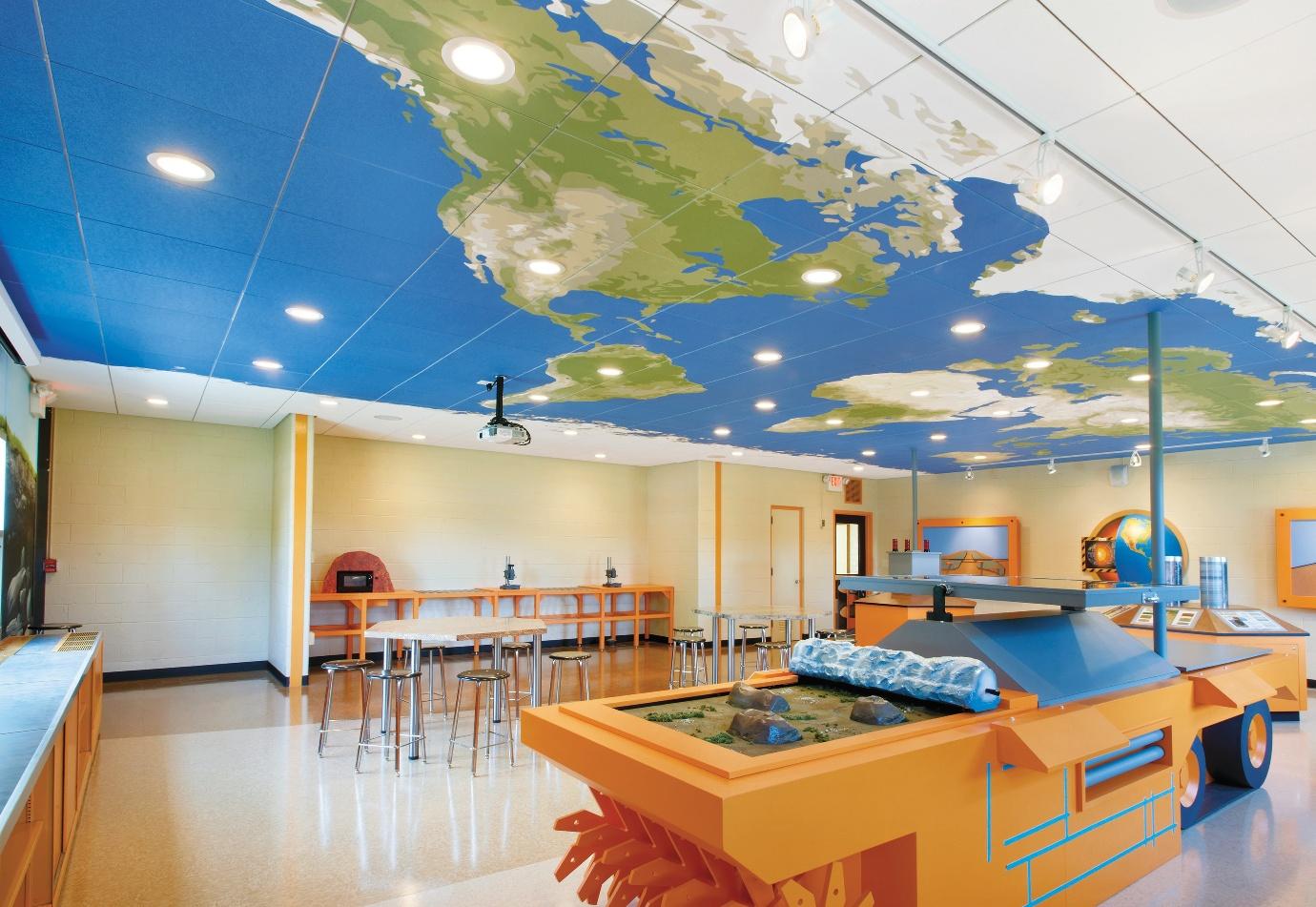
The acoustical ceiling installed in the earth studies room of Springmill Learning Center in Mansfield, OH, does more than control acoustics. Featuring a full-color image of the earth, the Armstrong Ultima Create! ceiling also serves as a teaching tool. Design: Splashmakers LLC, Mansfield, OH.
Struggling To Hear, Learn, And Teach
Poor classroom acoustics have a negative impact on student comprehension, engagement, and learning.
Kenneth W. Betz, Senior Editor
Hearing difficulties are most often associated with persons of advanced age, so it may come as a surprise that many schoolchildren face serious hearing challenges. Classrooms in the United States typically have speech intelligibility ratings of 75% or less, meaning every fourth spoken word is not understood, according to an often-quoted study.
“The problem is that classrooms are designed, built, and financed by normal-hearing, native-speaking adults but are occupied and used mostly by children. For adults, a speech intelligibility rating of 75% is not that bad. However, children do not have the hearing or comprehension maturity of adults. In classrooms you have to consider the population that are not native language speakers and that as much as 25% of the students have ear infections. This can result in decreased levels of concentration, comprehension, and stress,” said Sean Browne, principal scientist, Global Acoustics, Armstrong Commercial Ceiling Systems, Lancaster, PA.
“We know that children under the age of 15 years require more favorable acoustic environments than older children to achieve similar levels of speech recognition,” said Samantha Gustafson, AuD, CCC-A, FAAA, project coordinator, Listening & Learning Lab, Vanderbilt Univ., Nashville, TN.
“Therefore, the speech intelligibility rating of a classroom will be highly influenced by the age of its occupants. Because buildings are not often constructed keeping in mind the age of occupants in each room, we are missing the mark on providing learning environments that offer optimal opportunity for speech perception to the majority of students,” she said.
“Classroom acoustics are also important for teachers, who might be at increased risk for voice problems
due to high levels of noise. It is well understood that a speaker naturally increases the level of their voice in the presence of increased ambient noise levels; this is called the Lombard Effect. Recently, it has been reported that teachers in highly reverberant environments report lower job satisfaction, reduced energy, and increased interest in leaving their job,” Gustafson said.
LACK OF AWARENESS? Industry insiders are divided about why so many classrooms have poor acoustics. Were designers simply not aware of acoustical issues or was it a lack of funds that resulted in classrooms that limited the learning capacity of students simply because of poor acoustics?
Browne doesn’t think it’s a lack of awareness. “Acoustics in the classroom are pushed heavily in the industry. All of the material manufacturers push this message as does the Acoustical Society of America, American Speech-Language-Hearing Association, and the U.S. Access Board. There is an ANSI standard that focuses on classroom acoustics, and there are LEED points available for acoustics in classrooms. There are many older buildings that were constructed when different standards were in place. As they outlive their utility and new modern buildings go up in their place, I believe current classroom acoustics standards will be utilized,” he said.
Scott Riedel, president, Scott R. Riedel & Associates Ltd., an acoustics consultant based in Milwaukee, disagrees: “Most often it seems that a poor acoustic learning environment is caused by a lack of awareness. Acoustic factors are difficult to remember or imagine in a design planning stage; such factors are not always visibly apparent at the drafting board or screen. An out-of-sight-out-of-mind approach often is the reality during design.”
As far as cost is concerned, “while acoustic design service may have a cost, acoustic design implementation can be quite inexpensive,” Riedel said. “For example, a classroom must have a ceiling. Whether that ceiling is made of sound reflective, sound absorbing, or sound diffusing materials, the cost difference might be modest, but the difference in acoustic results can be vast. The cost, measured in poor educational results, from a poorly designed educational space, can be far greater than the cost, measured in dollars, for either a design service or materials selection.”
The age of school buildings and, consequently, the prevailing standards when they were built, is another explanation for the poor acoustical performance of some classrooms. “The average age of school buildings in the U.S. is 42 years. Almost half of our existing school buildings were built hurriedly between 1950 and 1969, when the Baby Boomer population surge hit our nation’s education system,” said Gary Madaras, Ph.D., Assoc. AIA, an acoustics specialist with Rockfon, Chicago.
“Since then, there have also been a couple of bad building phases where people thought open plan schools were a good idea. So, the problem is that too many bad sounding schools, built before the current awareness of the importance of classroom acoustics, are still being used,” he said.
“About 15 years ago, the acoustics industry got together and developed a standard: ANSI S12.60 (2002) Acoustical Performance Criteria, Design Requirements and Guidelines for Schools. That was a huge step in that it defined for educators and designers how to build classrooms with good acoustics for efficient and accurate communication. This standard is also referenced now by LEED when designing schools and CHPS (Collaborative for High Performance Schools, Sacramento, CA),” Madaras explained.
Robert Marshall, manager of marketing technical services, CertainTeed Ceilings, Valley Forge, PA, sees a similar progression in classroom acoustics and particularly credits LEED with increased attention to the acoustic performance of classrooms. The suspended ceilings that introduced acoustics
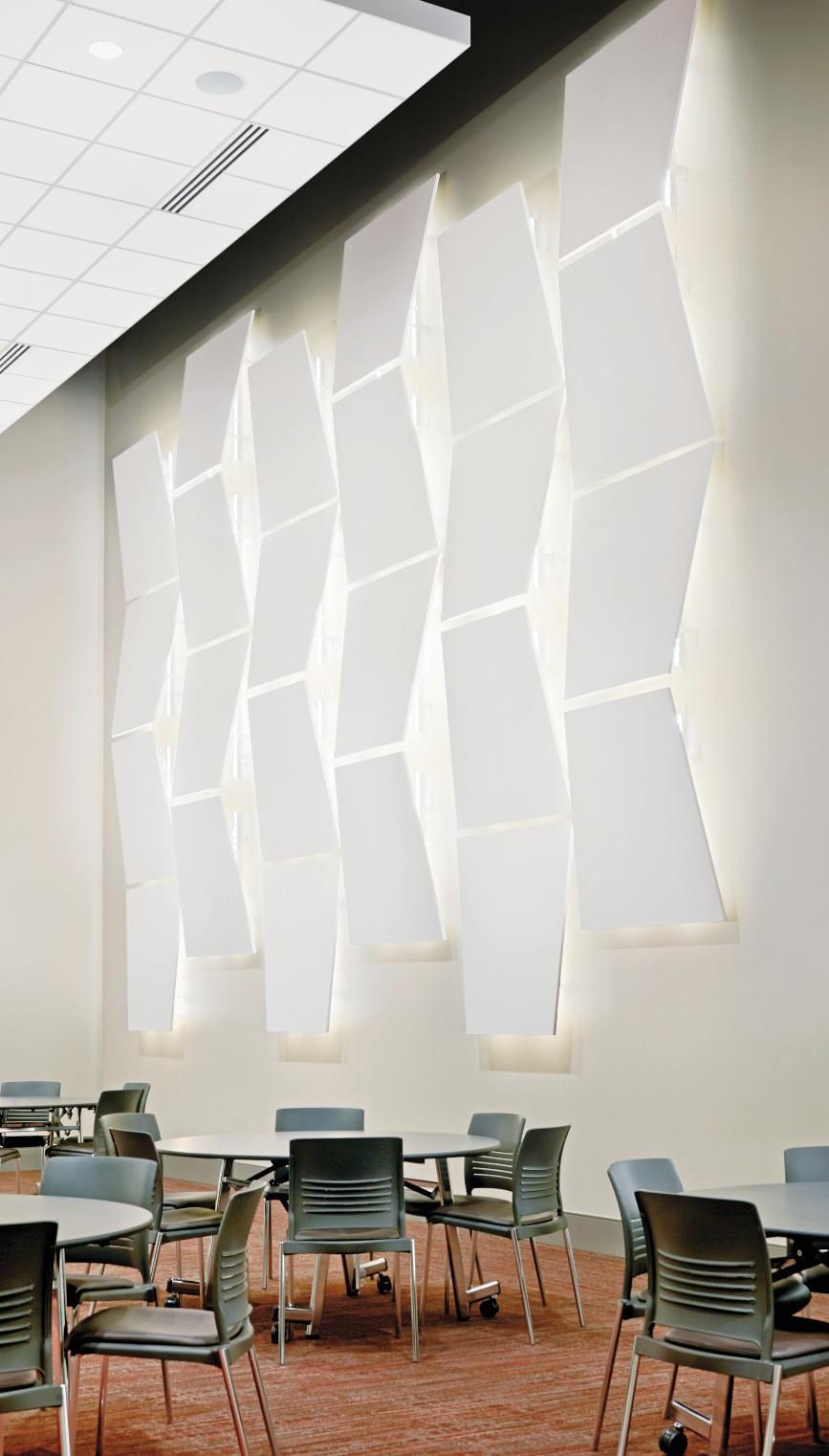
Installed on the wall of the cafeteria at Clover Hill High School in Midlothian, VA, Armstrong SoundScapes Shapes acoustical clouds reduce noise levels and enhance speech intelligibility in the large, open space. Architect: BCWH, Richmond, VA.
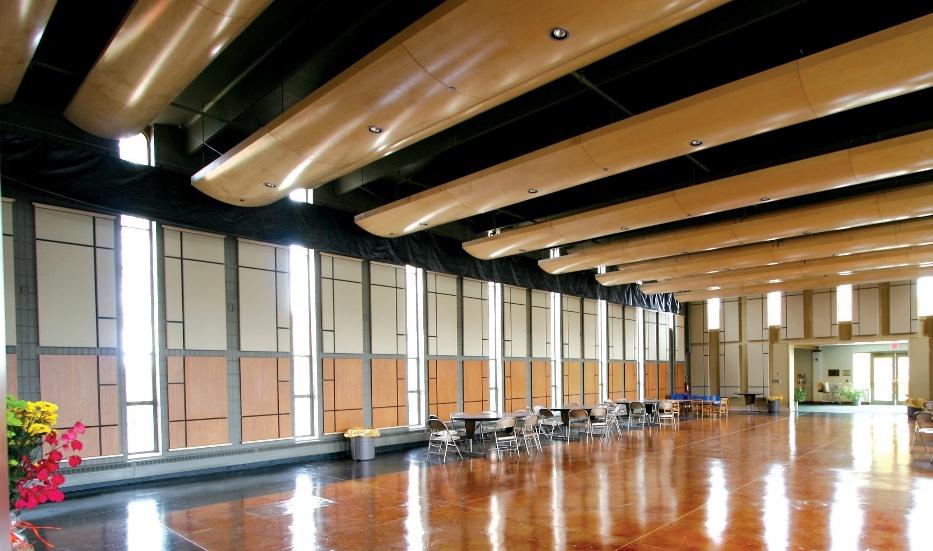
Top. This multi-purpose meeting room and cafeteria features sound-absorbing treatments to reduce ambient and background sound. At the same time, some sound-reflective and -diffusing treatments support and distribute speech and music during activities and presentations. Photo: Scott R. Riedel and Associates.
Above. High background noise or too much reverberation degrade communication between students and make it difficult for them to clearly understand the teacher, especially for those students who may have hearing impairments, learning disorders, or speak English as a second language. Photo: USG.
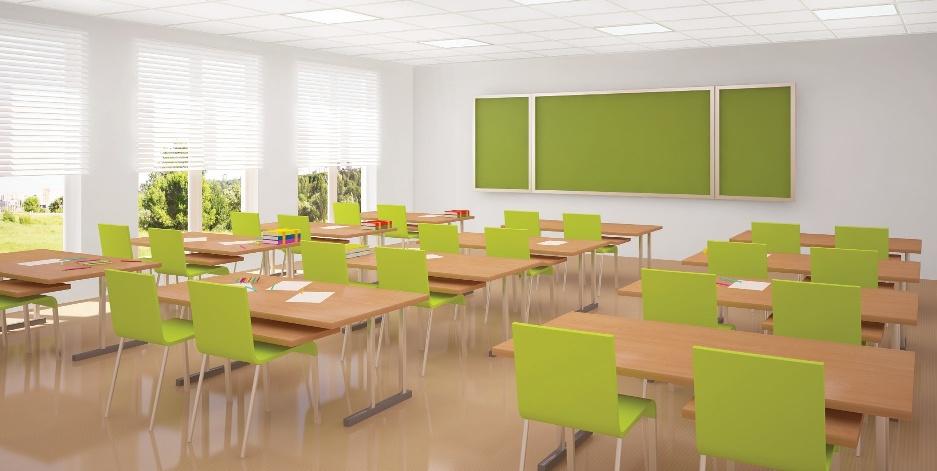
into the classroom in the 1960s were arguably better than the exposed plaster that predated them, which has almost no acoustical value, but the degree of acoustic value provided by the new ceilings was not really an issue at that point, according to Marshall.
Attitudes toward acoustics changed with the introduction of the USGBC LEED point system, which recognizes and awards points for classroom acoustical design, he observed. “It wasn’t just that they [USGBC] said it was a good idea. They said you cannot get any LEED certification for schools unless you address the acoustic quality of classrooms,” he said.
“All of a sudden, school boards were asking architects if they could design their school or renovation according to the LEED protocol, and it opened the door that had been shut for many decades,” Marshall said.
Mark Kemerling, product manager, acoustical panels, USG, Chicago, commented, “It may not specifically be a lack of awareness; it is more a lack of appreciation. Most architects, designers, and school officials understand the concepts at a very high level. Most also can easily understand the remedies needed to facilitate that improvement. However, during the budgetary, design, and construction phases, the value placed on this often gets pushed aside or minimized in order to meet other drivers, such as cost.”
CAUSES Poor classroom acoustics generally can be attributed to a handful of recurring and generally recognized factors. One of these is signal-to-noise ratio and the other is reverberation. Noise from outside or from mechanical systems factors into the signal-to-noise ratio.
“The signal is the teacher’s voice—the sound that is good and needs to be heard. The noise part of the ratio is anything that can interfere with the signal, and there are a lot of sounds that can do that: traffic noise or plane flyovers transmitting through the windows, heating and air conditioning equipment located inside the classrooms, and occupant noise transmitting through the door to the corridor,” explained Rokfon’s Madaras.
“One other type of noise that is often overlooked, but interferes with the teacher’s voice, is reverberation. When the teacher speaks, the first sounds that arrive at the students’ ears are very useful and important. They are the necessary signal. But, if the room has a lot of sound reflective surfaces, the teacher’s voice bounces around inside the room, interfering with the intelligibility of the subsequent words,” Madaras said.
The geometric form of the room also is a factor in classroom acoustics. “Is sound energy evenly distributed in a space, or are there ‘hot’ and ‘dead’ spots?” asked Scott Riedel. “Interior finish materials are important. The ratio of sound-reflective to sound-absorbing materials is important, as is their placement to achieve clear and even sound distribution,” he added.
SOLUTIONS “An acoustical ceiling with high NRC (noise reduction coefficient) and high CAC (ceiling attenuation class) will provide absorption to reduce the reverberation and blocking to reduce the intrusion of sound from mechanical equipment and neighboring activity. In addition, wall treatments can be used to further reduce the reverberation in the space,” offered Armstrong’s Browne.
Other things to watch out for are door and window seals, door sweeps, and penetrations in walls. “There are solutions that fit almost any construction situation and any budget. Existing facilities do present some access challenges, but there are acoustical ceilings that can fit tight to structure and there are free hanging baffles, clouds, and canopies that can be used to absorb sound. Also, HVAC contractors can tune noisy equipment or add noise suppression accessories to deal with mechanical noise at the source,” Browne added.
“Ensuring that classrooms have enough sound absorption in them so that reverberation time does not exceed 0.6 seconds (per ANSI S12.60) just involves some preliminary calculations to determine how much material is needed and then installation of lightweight materials overhead. The metric for quantifying a material’s ability to absorb noise is noise reduction coefficient (NRC). It varies between 0.0 (low sound absorption) and 1.00 (high sound absorption). If you use lower-performing materials (NRC 0.70 or lower), you have to buy and install a lot more of the material to reach the goal reverberation time of 0.6 seconds. The
One other type of noise that is often overlooked, but interferes with the teacher’s voice, is reverberation. If the room has a lot of sound-refl ective surfaces, the teacher’s voice bounces around inside the room, interfering with the intelligibility of the subsequent words. Photo: Rockfon.


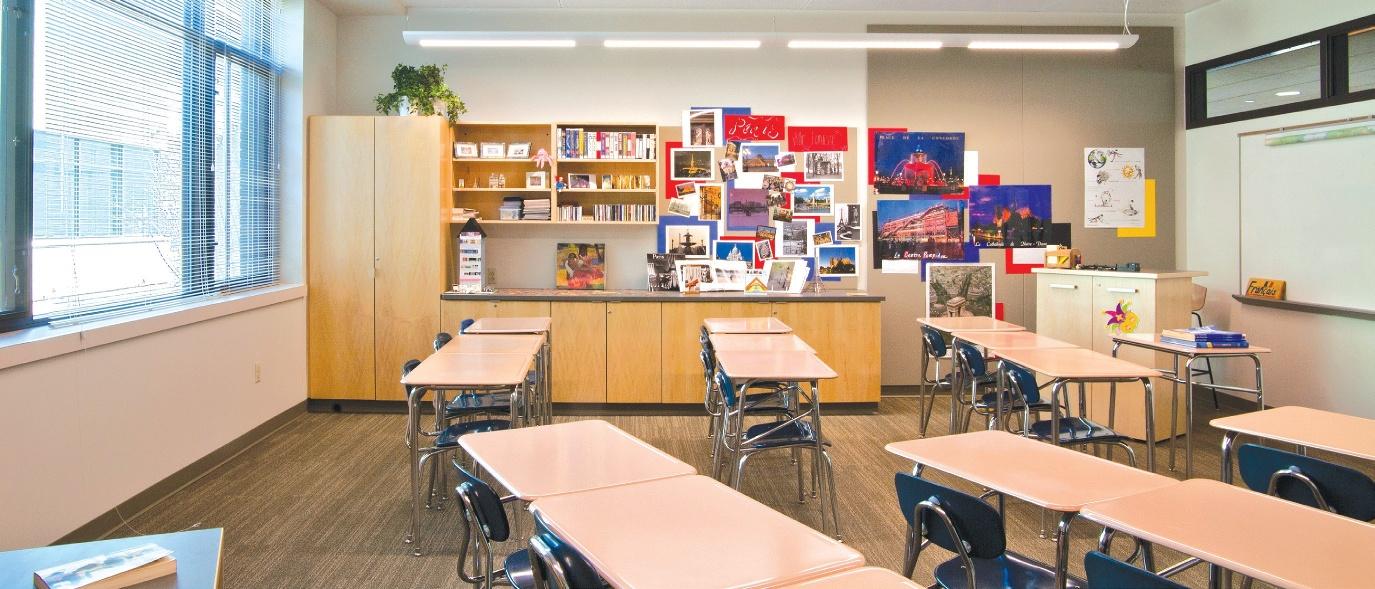
higher the NRC of the material, the faster you decrease reverberation,” Rockfon’s Madaras said.
He continued, “Older schools may have suspended acoustic ceiling tile, but there’s a good chance that they still don’t reach the goal reverberation time because the older ceiling tiles have very low NRC values of 0.60, 0.50 or less. It’s relatively easy to bring a classroom into compliance with the maximum reverberation time criterion in ANSI S12.60 by swapping the existing ceiling tiles with high-performing ceiling panels of NRC 0.90 or higher. The suspension grid can be reused.” “Depending on the problem or deficiency, it is always more challenging to remedy the situation after the fact, and usually more costly,” USG’s Mark Kemerling said. “First and foremost, if a school finds itself in this situation, they should consult a professional acoustician. In a typical U.S. classroom, subtle and lower-cost solutions would include enhancing the ceiling panels by selecting products that absorb or block sound more or less than what is currently installed. Which one is used depends on the type of problem the school is experiencing. Other options would include introducing reflectors to redirect unwanted sound, or even possibly the introduction of sound-masking systems. These systems generate a white noise which, in some cases, may be what is prescribed,” he said.
OTHER OPTIONS While acoustic ceiling tiles solve many noise problems, other solutions may be useful as well. “For noise sources originating from inside the school building, it is generally most cost-effective to relocate the classroom to a quieter area of the building, e.g., not adjacent to high-noise areas such as a gymnasium. Developers
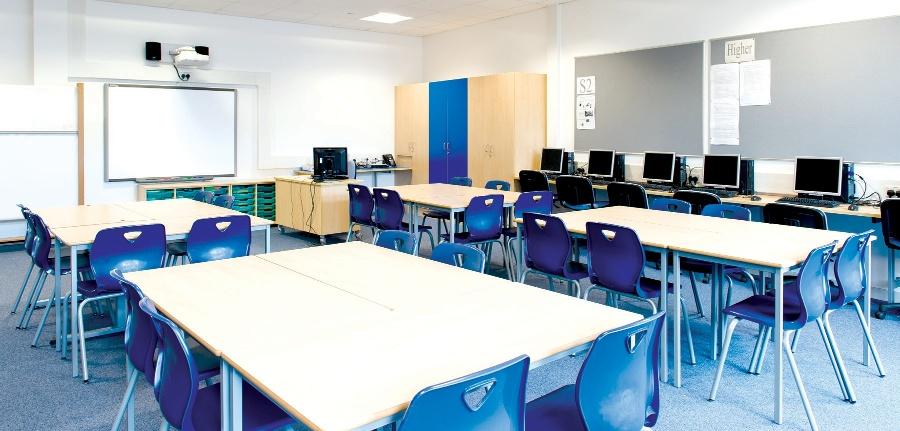
Ensuring that classrooms have enough sound absorption in them so that reverberation time does not exceed 0.60 sec. (per ANSI S12.60) involves some preliminary calculations to determine how much material is needed and then installation of lightweight materials overhead. Photo: Rockfon.
should include one area of dead space, e.g., a storage area, between high-noise sources and classroom learning environments. If relocation is not an option, double walls on the interior and/or well-fi tted and sealed doorways to hallways might be considered. Absorptive surfaces like carpeting, drapes, and acoustic ceiling tile can also be used in hallways, which can contribute signifi cantly to the level of competing noise entering a classroom from other areas inside the school building,” Vanderbilt’s Gustafson said.
“To address the reverberation problem, absorptive surfaces like carpeting, drapes, and acoustic ceiling tile can combat reverberation in rooms with highly reflective surfaces,” Gustafson added. “Portable corkboards can also be hung on the walls and are more effective at combating reverberation if hung at an angle.”
However, the frequency of the sound to be controlled is important in the selection of sound-absorptive materials, Gustafson cautioned. “Many materials used for absorption of sound are much more efficient at absorbing high-frequency sounds, compared to low-frequency sounds. This is ironic, as low-frequency noise in the classroom has a greater effect on speech perception than high-frequency noise. Therefore, measuring the reverberation time in multiple frequency ranges may be useful when evaluating the effect of acoustic modifications in classrooms,” she said.
“Unfortunately,” Gustafson observed, “many schools seem to be moving away from absorptive materials in classrooms and toward more hard surfaces (concrete or wood floors, fully windowed walls). While this trend may be more aesthetically appealing and
easier to maintain, the consequences of these reflective surfaces are often not addressed and may prove harmful to the education of students and the well-being of teachers.”
Quiet classrooms are much more necessary for students that have learning or developmental disabilities, students who have had ear buds in their ears for too long and have lost hearing that nobody should lose at that age, and students who, on any given day, may have an ear infection or a cold that limits their hearing by 20% to 25%. All of these kids are mainstreamed into a single classroom where the normal-hearing student is sometimes a minority. “The people occupying these seats are not just those students in need of a quiet classroom; they’re students with needs beyond those of a normal-hearing person,” CertainTeed’s Marshall said.
“In the end, it seems to always be about tradeoffs. In today’s environment of tight budgets and compressed design and construction schedules, the ‘acoustic lobby’ gets overshadowed by other things. Like many other important design rules, until it is in the code in a quantifiable and measurable performance metric, it will continue to get minimized. One way to guarantee better acoustics would be to build post-occupancy acoustic performance metrics. Essentially, setting minimum standards for acoustic performance based on the functionality of each space and linking this performance to the government funds would help support these schools. This would drive change,” said USG’s Mark Kemerling.
While progress has been made toward quiet classrooms where speech intelligibility levels meet the needs of all students, not just normal-hearing individuals, and where teachers do not have to raise their voices to be heard, architects, designers, and school officials need to join together to make classroom acoustics a universal priority, not an afterthought or a tradeoff. CBP
Want more information? The resources below are linked in our digital magazine at cbpmagazine.com/digital/mar2015.
Learn more from acoustician, Gary Madaras, in a Commercial Conversation podcast.
See more insights and photos from the acoustics experts quoted in this article.
Download the Acoustics in Schools white paper from the Ceilings and Interior Systems Construction Association.
Download the Architectural Acoustics document from the American Institute of Architects.
Learn more about classroom acoustics at the Acoustical Society of America website.
Download the Guidelines for Addressing Acoustics in Educational Settings document from the American Speech-Hearing-Language Association.
Answer the question What is the ANSI standard? at the American SpeechHearing-Language Association website.
Ken’s View
Noise, if you haven’t heard, is a big deal these days. Not that there hasn’t always been noise. However, prior to the dawn of the Industrial Revolution, cows and horses were reasonably quiet and agreeable components of the rural lives most people lived. Save for inconsiderate roosters, chickens clucked quietly to themselves and rabbits had little to say. Power tools, lawnmowers, airplanes, and automobiles hadn’t been invented. Mechanical clanking and roaring was kept to a minimum.
The key word here is noise. Noise is a judgmental word that usually means sound we don’t want to hear, such as music favored by a generation younger than your own or unselfconscious cell-phone conversations in public. Sound itself can be useful, as when informing the neighbors their house is on fi re. But allowed to run amuck, sound becomes noise.
Still, it comes as a something of a surprise that acoustics and noise are big concerns in classrooms today, even those that aren’t directly under the fi nal approach path of an airport. I don’t remember not being able to hear the teacher when I was in school—back when there were wooden fl oors, high plaster ceilings, blackboards with screeching chalk, and large windows.
But kids those days didn’t have hearing defi ciencies, weren’t allergic to peanuts or cats, and didn’t suffer from attention defi ciency or other disorders—at least we weren’t aware of the problems. We probably didn’t even know what acoustics were. Above all, it was a time and place where all of the women were strong, all of the men were good looking, and all of the children had aboveaverage hearing—with apologies to Garrison Keillor and the inhabitants of his make-believe Minnesota village.
Well, times have changed, and so has noise. There’s a lot more of it. And it’s irritating and counter productive. Not just in schools. Noise is one of the biggest complaints in hospitals, and uninvited chatter is one of the reasons open offi ces fail to thrill everyone who works in them.
Then, too, there are the ubiquitous TV screens that have crept into public spaces—airports, restaurants, doctors’ waiting rooms, hotel lobbies, you name it. They blather on about this or that terrible thing that may befall viewers if they don’t stay tuned to the next story—coming up after this word from the sponsor of the moment. Some call it TV pollution, some call it ambient TV. Never mind what I call it.
Noise, television or otherwise, is not benign. It can cause people to be irritable and anxious—and as a nation we’re irritable and anxious enough as it is. We seem to have grown accustomed to second-hand noise, even though, according to the Environmental Protection Agency, problems related to noise include stress-related illnesses, high blood pressure, speech interference, hearing loss, sleep disruption, and lost productivity.
So why, then, are automakers seemingly conspiring to make automobiles noisier? Perhaps because some cars today are too quiet. Electric cars, and even hybrids, creep up, unnoticed, on unwary pedestrians. Car makers are said to be seeking a solution.
But they’re also trying to make cars noisier in another, one might say dishonest, way. Seems that some drivers still want their rides to sound like muscle cars instead of wimpy sewing machines, and auto makers have taken to supplementing the quiet hum of today’s vehicles with fake engine noises that emulate yesterday’s authentic V8s. They don’t always tell customers the throaty roar isn’t coming entirely from their engines.
Imagine that these sound generators somehow got out of sync, as gizmos often do, and started making engine noises when there should be none? Don’t think it couldn’t happen. It’s a given that electronic gizmos behave badly sooner or later. Chicago’s Union Station, for example, has an automated announcement system that, when I recently passed through said transportation hub, was stuck in a loop, repeating the same nonsensical phrase over and over again. More noise.
Some years ago, someone invented a remotecontrol device call TV-B-Gone that could turn off televisions in public places. Apparently now there’s an app for that (of course there is). Wonder if it would work on that disembodied Union Station voice?
Somewhere there’s an eighth-grade geek dreaming of inventing a Teacher-B-Gone app. Perhaps he or she already has devised one, judging from the test scores of some students. My advice: Don’t do it, kid. Listen to the 75% of what you can hear your teacher saying. Maybe you’ll learn something interesting and be able to share it in more than 140 characters.







